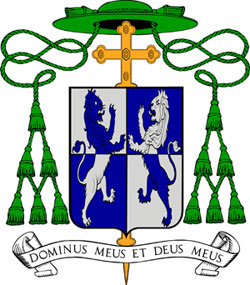The Coat of Arms of
The Most Reverend Daniel E. Thomas, D.D., S.T.L., V.G
Titular Bishop of Bardstown
Auxiliary to the Archbishop of Philadelphia

In designing the shield – the central element in what is formally called the heraldic achievement – a bishop has an opportunity to depict symbolically various aspects of his own life and heritage, and to highlight particular aspects of Catholic faith and devotion that are important to him. Every coat of arms also includes external elements that identify the rank of the bearer. The Holy Father regulates the design of coat of arms, and the insignia appropriate to each rank of the hierarchy through instructions issued by the Secretariat of State of the Holy See. The formal description of a coat of arms, known as the blazon, uses a technical language, derived from medieval French and English terms, which allows the appearance and position of each element in the achievement to be recorded precisely without drawings.
The colors – called tinctures- that Bishop Thomas has chosen for his coat of arms allude to the arms of the Archdiocese of Philadelphia, where the primary tinctures are also silver (argent) and blue (azure). The shield is divided quarterly or per cross, recalling the words of Saint Paul: “May I never boast except in the cross of our Lord Jesus Christ” Galatians 6:14).
The lions on the shield recall Bishop Thomas’ baptismal patron saint, the Prophet Daniel. The Book of Daniel (6:2-29) relates how King Darius forbade his subjects – including the Isrealites in exile in Babylon – to pray to any god or power other than himself for thirty days. When Daniel was found praying to the LORD, he was thrown into a den of lions. The next day he emerged alive and “unhurt because he trusted in God” (Daniel 6:24).
The face that there are two lions makes this achievement an example of “canting arms” – a design which incorporated a pun on the bearer’s name. The bishop’s family name, Thomas, him as “Thomas, called Didymus,” a Greek name meaning “twin”. The “twin” lions on the shield thus reflect the meaning of the name Thomas.
The motto, placed on a scroll below the shield, also calls to mind the story of Saint Thomas. Although disbelieving at first, when Saint Thomas beheld the risen Lord Jesus he confessed his faith declaring, “Dominus meus et Deus meus” – “My Lord and my God.”
The shield is ensigned with external elements that identify the bearer as a Bishop. A gold processional cross appears behind the shield; it is chased as jeweled with five gems recalling the five wounds of Christ. This too alludes to Saint Thomas, who wished to put his fingers into the nail marks in Jesus’ hands and the wound in his side. The galero or “pilgrim’s hat” is used heraldically in various colors and with specific numbers of tassels to indicate the rank of a bearer of a coat of arms. A bishop uses a green galero with the three rows of green tassels.